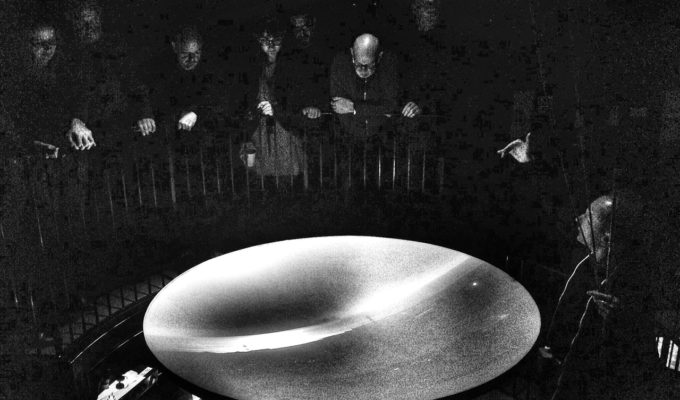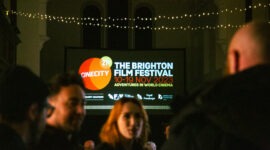
Re-reading They: A Sequence of Unease by Kay Dick
CINECITY’s Tim Brown salutes a timely re-publication of a forgotten novel – and recommends readers get out walking on the Downs.
Not on any map
Re-reading They: A Sequence of Unease by Kay Dick
In Kay Dick’s slim novel, first published in 1977, They are mysterious gangs who roam the countryside removing and destroying all art, books and paintings and ‘gleaning’ – killing or maiming – artists who resist. I first read They aged 18 and having grown up in the countryside in the 1970s, the novel struck something of an immediate chord. While dystopias frequently have an urban setting, there was a 70s strain of rural dystopic Science Fiction with teatime dramas such as The Changes (first broadcast in 1975) about a group who escape the city for the countryside amid a breakdown in society, quickly followed by Survivors (1975-77). With the classic Village of the Damned (1960) seemingly regularly on television, the sense that the idyllic countryside was not all it seemed was already very familiar.
We reached the kissing-gate that led out to the downs. ‘Let’s kiss for luck,’ I said. We climbed the first hill and stood at the top of the ridge. We could see all over the downs. To our left the sea. Larks soared and dived above our heads.
I re-read They when I moved to Brighton many years later and, with the Sussex Downs on the doorstep, my appreciation of the novel and Kay Dick’s writing greatly increased. The slim volume is full of an iconography recognisable to all those who know and love the Downs – valley of wheat, woods, estuary, Old Rectory, cliff road, Norman church, canopy of trees, coastguard’s cottage, kissing-gate, lighthouse, Victorian viaduct. But this is a familiar landscape made strange. At one point the narrator wills herself to be a physiological addition to sea and beach. Identification with the landscape gave an illusion of invisibility. Such is the vividness of the prose, I invariably think of the book when I walk on the Downs; scenes replayed in the mind or a location ready for action but often more an essence or atmosphere.
We stood quite still. Everything hummed with summer. We had turned off at the Victorian Viaduct, into the woods, mounting slowly, until a decline brought us in sight of the valley. Acres of wheat glowed amber in the August afternoon.
They is rich with descriptions of nature; while no idyllic haven, the rural is still ‘the best refuge and repository of value in a time of barbarianism’ as a contemporary review noted. Writer Graham Duff highlights that Kay Dick is ‘using nature and the countryside as an analogue for art and creativity. Here is natural, unmediated beauty and visual display… The lead characters – the artists – have retreated from the city, from the conflict into hidden away places in the countryside. One can easily read this as a desire to return to an Edenic state in the face of possible destruction.’
Downlands radiated colour. Brownish defoliated areas glinted purple tones… Sodden lumps of green turf felt like moss under my tread. I looked at the cerulean blue of the sky framing curves and inclines.
an undulation of variegated green splashed here and there with the yellows, mauves, pinks of flowering shrubs.
Skies of Prussian blue or burnt sienna, a cinnamon stretch of sand, They is a riot of colour; the brilliant colours of nature but also those of the artists’ palette. One character, Claire obsessively paints single colour canvases, It was yellow, all yellow, every variation and depth of yellow. Then the canvas she was painting was blue, all blue, every variation and depth of blue. And on through canvases of green, red and finally, white.
The Sussex Downs are criss-crossed by artists’ houses – Charleston, Monk’s House, Farleys House, Furlongs Cottage – which have provided home and inspiration to a great many artworld figures and a host of visiting international guests. This gives an added poignancy to one of the central motifs of They – the removal and destruction of all books, paintings, instruments and sculptures from people’s homes. In some ways the whole book can be read as a manual or manifesto for all artists – not just the established or famous. Though the artworks in They are invariably taken away and destroyed, as one character states: Destruction doesn’t count. One can always create again. The narrator asks Can we go on creating for ourselves? Without any contact with the outside world? Just as the artists’ houses above sat side by side with working farms and part of agricultural communities, it is the process of continually making work that matters most.
‘Hallo love,’ I said, every day to each morning. A greeting to space and time. A ritual. Keeping my hand in. It was always possible that through space and time it might be heard.
Kay Dick herself described They as not overtly political and ‘mainly concerned with people working in the arts (young people) and deals with the problems and anxieties which afflict them today.’ In the face of destruction or indifference (‘There are worse crimes than burning books. One of them is not reading them.’- Joseph Brodsky), the artist must simply continue.
‘It is not down on any map; true places never are.’ Herman Melville
Indoors, I studied an ordnance survey map of our part of the coast. In red pencil I crossed the places where they had left their mark. I linked the crosses together in blue ink; it made an incomplete circle.
Kay Dick moved to Brighton in the late 1960s and made her home on the seafront in Arundel Terrace. In an article for the Paris Review in 2020 hailing They as a lost masterpiece, Lucy Scholes wondered whether the naming of one character in the novel, Berg, is a coincidence or a kind of homage to experimental writer Ann Quin’s debut novel Berg, published in 1964. When Ann Quin died swimming off the sea in Brighton in the late summer of 1973, she was a near neighbour living in Lewes Crescent just around the corner from Kay Dick’s home. Just as Berg is set in an out of season seaside resort, never named but a version of Ann Quin’s hometown of Brighton so, the landscapes of They are clearly inspired by the Sussex countryside and coast.
My admiration for the book and its cinematic qualities led to an event as part of CINECITY The Brighton Film Festival in 2014; the location just outside Brighton was Foredown Tower, built in 1909 as a water tower for the nearby isolation hospital. Its viewing room on the top floor gives outstanding 360° views of the coast and downs and also houses the region’s largest camera obscura, used to observe the surrounding landscape and sky. In They artists are sent to tall, imposing, window-less towers where they are desensitized and purged of their memories and emotions. The event, part of the BFI’s UK-wide Science Fiction season Days of Fear and Wonder, presented the intensely cinematic They as a kind of imaginary film with live readings from the novel by actor Hugh Ross, a talk from Graham Duff (Ideal, The Nightmare Worlds of H.G. Wells) and a demonstration of the camera obscura. They has never been filmed but in this way a number of elements that can constitute a film were present – script/text, location, moving images (camera obscura) and, with the live readings, an element of performance. They considers the landscape of the South Downs as a site of menace and alongside the vivid descriptions of nature, there are moments when sinister mobs are on the march across the countryside and beaches of coastal Sussex. (Operation Sealion, the planned Nazi invasion of England, was to have started with paratroopers landing on the Downs). In its own unique way, the camera obscura was able to scan the South Downs to great effect, picking out movement and figures in the landscape, to create a suitably strange and at times, otherworldly experience.
Whether They, along with John Wyndham’s Midwich Cuckoos and Day of the Triffids – and the award-winning, private Nithurst Farm, built in the South Downs National Park in 2019 and intriguingly partially inspired by Andrey Tarkovsky’s Stalker – can be seen as Sussex Sci-Fi, one can only hope that the timely re-issue of Kay Dick’s brilliantly written book will lead to a new generation of admirers.
Tim Brown is Co-Director of CINECITY, based at the University of Brighton, which presents the annual Brighton Film Festival and a year-round programme of screenings and special events.
